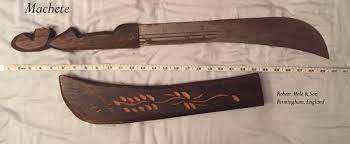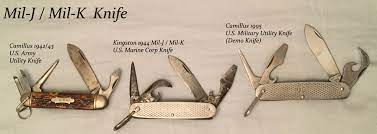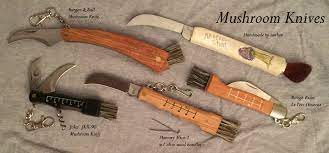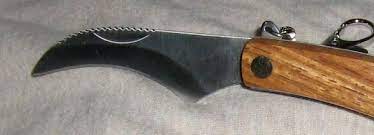![]()
Return to Index/Main Page
| A lexicon of knife terminology: Section M | ||||||||||||||||||||||||||
| Numbers | A | B | C | D | E | F | G | H | I | J | K | L | M | N | O | P | Q | R | S | T | U | V | W | X | Y | Z |
Machete: A large knife, normally with a wide blade 12-24 inces in length used primarily for cutting brush but at times is used an weapons. It is commonly used anywhere heavy brush needs to be cleared. Because machetes were often locally made, their size and shape vary greatly depending due to the needs of the local population. (For comaparison see bolo, golok, kukri, and parang)

Mako: A small frame lock back knife made by Case or any of a variety of small frame lockbacks that resemble the Case Pattern. The frame gracefully swells as it approaches the rear of the knife.
Manganese: An important element, manganese aids the grain structure, and contributes to blade hardness. It also improves strength and wear resistance. It is present in most cutlery steel.
Manicure Knife: Typically a key chain type knife consisting of two or three small blades held in a stainless steel channel with a single rivet. The blades do not lock nor are they held fast with a slip joint spring. The main blade is a file, normally with a cuticle tip, the second blade is normally a small sheepfoot. If a third blade is present it is normally a combination cap lifter/screwdriver. At one time these were commonly used for advertising.
Mark Side: The side of the knife that has the shield or mark inlaid. Also called the obverse, shield, or front side of the folding knife.
Marline: a small cord of two loosely twisted strands, used as for winding around ropes or cables to prevent fraying (contraction of marine line)
Marlin Spike: On a folding knife, a pick like blade commonly found on nautical knives used for undoing knots and splicing lines. The marlin spike can also be fixed blade knife resembling an ice pick or a large sewing needle. Often an elongated hole is found on the non pointed end of fixed marlin spikes. This hole doubles and a shackle key. (Sometimes spelled: marline spike or marlinspike)

Martensitic Stainless Steel: Martensitic steels are low carbon steels built around the Type 410 compostion It normally contains 12% chromium, and 0.12% carbon. While Martensite gives great hardeness to the steel it also casue the steel to be brittle so few steels are fully hardened.
MasterCraft: A line of knives made by Robeson which had bronze bearings mounted on the ends of the tangs along the surface that bore on the back spring. This reduced wear on the tang, and facilitated easy opening. Most were etched, “NEV-R-BIND OILESS BEARINGS” in a scroll banner on the master blade. MasterCraft knives had a nickel-silver “MASTERCRAFT” shield with a black background. (Later made Robeson’s from the Ontario factory do not have the bronze bearings.)
Match Strike (Pull): A nail nick on a knife with groove surfaced that will allow the owner to (in theory) light a strike anywhere match on its surface.

Melon tester: A long slender slip joint knife with long spear point blade used for cutting and testing fruit, especially melons. The knife handle is often five or more inches long. Blade length is often 4 or more inches. The knife often has a serrated blade to aid in cutting melons. In some cases, the knife may have two blades set in opposition on the handle like a penknife. Aslo called a fruit knife.

Micarta: is a trademark of Norplex-Micarta. The material is essentially linen, or other cloths or papers impregnated with resin plastic that are comined together under high pressure and heat to creat a highly durable compound that is impervious to moisture and able to take repeated impact. Micarta was developed by George Westinghouse as early as 1910 by combining phenolic resins invented by Dr. Leo Baekeland with paper and cotton fabrics..
Mil-J Mil-K Knife: During World War II the U.S. War Department worked with knife makers to solve two problems facing the current 4 blade utility knife in use. The first problem was the scales on the knife were prone to breakage and the second was the operation of the can opener led to soldier cutting themselves as the opener cut upward. Both problems were solved with a knife that was first used by the Nay Department under the Designation Mil-J (Military Jack-Knife) and later changed to Mil-K (Military Knife)
The first of these knives were adopted and used by the U.S. Marines. It featured textured Stainless steel slab sides with brass liners and carbon steel blades. The new features included the newly developed Safety Can Opener. The Mil-K was later feature all stainles steel parts. The Mil-K is commonly called G.I. Utility Knife, Demolition knife or Demo Knife.
Mini Copperhead: A pattern name used by W.R. Case & Sons for a 3 1/8 inch pen-knife with a slim serpentine frame having an upward bend on the end where the pen blade is located. The main blade is normally a clip blade however more recently a wharncliffe blade have also been used. The pattern is also known as a baby or tiny copperhead, especially when made by manufacturers other than Case. (Compare to penknife, Eisenhower, 1/2 whittler, and muskrat)

Molybdenum: A carbide former, prevents brittleness & maintains the steel's strength at high temperatures.
Moose: A traditional knife pattern. It is a large frame knife with the blades arranged in muskrat fashion, one on each end. One blade is normally a large clip and the second is normally a spay blade. See Muskrat and Trapper for comparison.
MOP: (See Mother of Pearl)
Mother of Pearl: A translucent material used for scale or handle material and harvested from pearl oysters (genus Pinctada). It comes in a variety of colors Most people simple call it pearl.
Muleskinner: A named used by some companies to describe a Sodbuster style knife. (Sodbuster is trademark of W.R. Case & Son)
Multi-blade: A knife with containing several special purpose blades and small tools such as screwdrivers, saws, scissors and corkscrews and almost anything you can imagine. They are often refered to as Swiss Army Knives or Swiss Style knives.
Multi-tool: A folding pair of pliers that has several tool blades attached to the ends of the hollow handles such as screw drivers, bottle openers, scissors and often a pen blade. The multi-tool was popularized by Leatherman and so the term leatherman is often used to describe any multi-tool.
Mushroom Knife: A traditional European pattern folding knife that normally has a modified hawkbill blade; often with gimping on the spine to aid in cleaning mushrooms. A small boar bristle brush mounted on the pommel which may swivel (newer models have synthetic bristles). Most are folding slip joints but some fixed examples exist . It is special horticulture knife used to collect wild mushrooms. (also called a Mycology Knife)

Muskrat: A traditional pattern folding knife; normally a thin serpentine knife 3 7/8 inches long closed, with two equal length California clip blades attached to each end. The California clip is so common to this knife pattern that the blade is often called a muskrat blade when used in other knives. (See also improved Muskrat, Hawbaker, and Moose)
Mycology Blade: A scythe shaped blade found on many mushroom knives and rarely seen on other knives.. (see hawkbill for comparison.)

Mycology Blade
Mycology Knife: A Mushroom Knife, a ttraditional European pattern folding knife that normally has a modified hawkbill blade and a small boar bristle brush mounted on the end. It is special horticulture knife used to collect wild mushrooms. (also called a Mushroom and Truffle Knife)
Return to Index/Main Page